A horizontal cylinder closed at one end contains an ideal gas which is compressed by a tight-fitting and frictionless piston. The piston is connected to the other closed end of the cylinder via a spring with spring constant . The piston is of cross-sectional area and mass . In equilibrium, the chamber containing the gas has pressure and length while the spring is compressed by . Let the the piston be displaced by towards the vacuum region, and released. Choose the correct statement(s) regarding the oscillations of the piston by assuming all processes are isothermal.
Important Questions on Simple Harmonic Motion
A particle of mass is attached to four springs with spring constant and as shown in the figure. Four springs are attached to the four corners of a square and a particle is placed at the center. If the particle is pushed slightly towards any side of the square and released, the period of oscillation will be
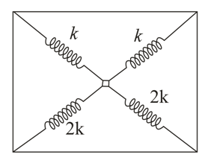

A tray of mass is supported by two identical springs as shown in figure. When the tray is pressed down slightly and then released, it executes SHM with a time period of . The spring constant of each spring is
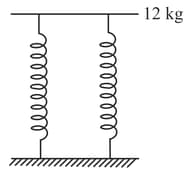

In the given figure, a mass is attached to a horizontal spring which is fixed on one side to a rigid support. The spring constant of the spring is The mass oscillates on a frictionless surface with time period and amplitude When the mass is in equilibrium position, as shown in the figure, another mass is gently fixed upon it. The new amplitude of oscillation will be:
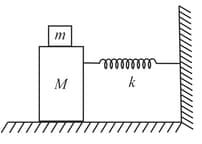
In the given figure, a body of mass is held between two massless springs, on a smooth inclined plane. The free ends of the springs are attached to firm supports. If each spring has spring constant the frequency of oscillation of given body is:
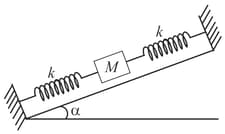
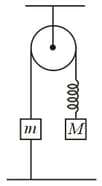
The pulley and the strings are massless and . The spring is light with spring constant . If the string connecting to the ground is detached, then immediately after detachment
Two identical springs of spring constant are attached to a block of mass and to fixed support (see figure). When the mass is displaced from equilibrium position on either side, it executes simple harmonic motion. The time period of oscillations of this system is :

[ is the acceleration due to gravity. Neglect friction]
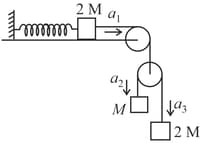
A solid block on a frictionless surface is connected to two rigid supports on the left and right side by springs of spring constants and respectively as shown in the figure. The time spent by the block in a complete cycle of oscillation on the left and the right side of the equilibrium position are and respectively. Which of the following is correct?


